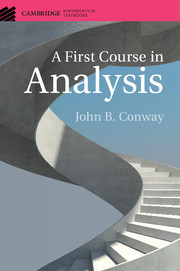In this chapter we begin the study of p-dimensional Euclidean space, Rp, but in this beginning we will carry it a step further. We want to discuss differentiation and integration on Rp, but first we need to extend the notions of sequential convergence, the properties of sets, and the concept of continuity to the higher dimensional spaces. The effort to explore these concepts in Rp, however, is not greater than what is required to explore these notions in what are called metric spaces. In many respects the abstract spaces are easier to cope with than Rp. Moreover some of what we have already done is properly couched in metric spaces. Indeed, the material of §4.1 can be set there with little additional effort. Nevertheless during this venture into abstraction the main set of examples will be Euclidean space.
We start with the concept of distance between points. This must be general enough to encompass a variety of circumstances, but it should conform to the intuitive notion we all have of what is meant by distance. Since this is done at the start of the first section, it would be profitable before proceeding for the reader to reflect on what properties (s)he thinks should be included in an abstract concept of distance; then you can compare your thoughts with the definition that starts the following section.
The treatment of metric spaces here is based on Chapter 1 of [4].
Definitions and Examples
Definition. A metric space is a pair of objects, (X, d), where X is a set and d is a function d : X × X → [0,∞) called a metric, that satisfies the following for all x, y, z in X:
(a) d(x, y) = d(y, x);
(b) d(x, y) = 0 if and only if x = y; and
(c) (Triangle Inequality) d(x, y) ≤ d(x, z) + d(z, y).
Condition (a) is sometimes called the symmetric property and says that the distance from x to y is the same as the distance from y to x. The second property says the obvious: the distance from a point to itself is 0 and the only point at a distance zero from x is x itself.
